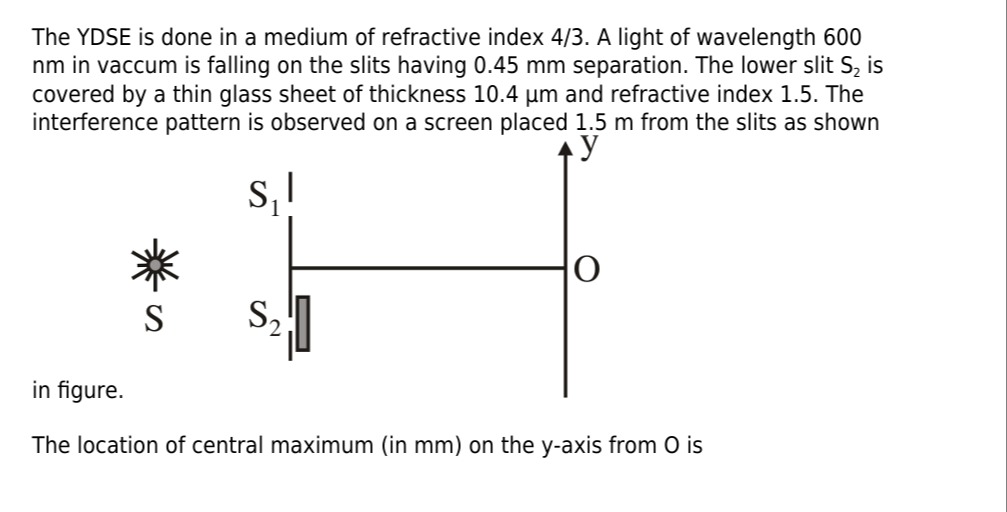Question
Question: The YDSE is done in a medium of refractive index 4/3. A light of wavelength 600 nm in vaccum is fall...
The YDSE is done in a medium of refractive index 4/3. A light of wavelength 600 nm in vaccum is falling on the slits having 0.45 mm separation. The lower slit S2 is covered by a thin glass sheet of thickness 10.4 µm and refractive index 1.5. The interference pattern is observed on a screen placed 1.5 m from the slits as shown
in figure.
The location of central maximum (in mm) on the y-axis from O is

-4.33
Solution
The central maximum occurs at the point where the optical path difference between the waves from the two slits is zero. Let the refractive index of the medium be nm=4/3. The lower slit S2 is covered by a thin glass sheet of thickness t=10.4 µm =10.4×10−6 m and refractive index ng=1.5. The slit separation is d=0.45 mm =0.45×10−3 m. The screen is placed at a distance D=1.5 m from the slits.
Consider a point P on the screen at a vertical distance y from the point O directly opposite the midpoint of the slits. The geometric path length from S1 to P is r1 and from S2 to P is r2. In the medium, the optical path length from S1 to P is nmr1. The light from S2 travels through the sheet of thickness t and then through the medium for the remaining distance. The geometric path length in the medium is r2−t, and in the glass sheet is t. The optical path length from S2 to P is nm(r2−t)+ngt. The optical path difference between the two waves at P is:
ΔOP=Optical path from S2 to P−Optical path from S1 to P ΔOP=(nm(r2−t)+ngt)−nmr1 ΔOP=nmr2−nmt+ngt−nmr1 ΔOP=nm(r2−r1)+(ng−nm)t.
For the central maximum, the optical path difference is zero: ΔOP=0 nm(r2−r1)+(ng−nm)t=0.
For a point P at a distance y from O, the geometric path difference r2−r1 is approximately yd/D for small angles (which is usually the case in YDSE). If y is positive (above O), r2>r1, so r2−r1=yd/D. If y is negative (below O), r1>r2, so r2−r1=−∣y∣d/D=yd/D. Thus, the approximation r2−r1≈yd/D holds for both positive and negative y.
Substituting r2−r1=yd/D into the equation for the central maximum: nm(yd/D)+(ng−nm)t=0 nm(yd/D)=−(ng−nm)t y=−nmd(ng−nm)tD=nmd(nm−ng)tD.
Given values: nm=4/3 ng=1.5=3/2 t=10.4×10−6 m D=1.5 m d=0.45×10−3 m
Calculate nm−ng: nm−ng=4/3−3/2=8/6−9/6=−1/6.
Substitute the values into the formula for y: y=(4/3)×(0.45×10−3 m)(−1/6)×(10.4×10−6 m)×(1.5 m) y=6−1×10.4×1.5×4×0.453×10−3×0.4510−6×1.5 y=6×4×0.45−10.4×1.5×3×10−3 y=10.8−10.4×4.5×10−3 y=10.8−46.8×10−3 y=−108468×10−3 Divide by 4: y=−27117×10−3 Divide by 9: y=−313×10−3 y≈−4.333...×10−3 m
Convert to mm: y≈−4.333... mm.
The location of the central maximum on the y-axis from O is approximately -4.33 mm. The negative sign indicates that the central maximum is below O.
